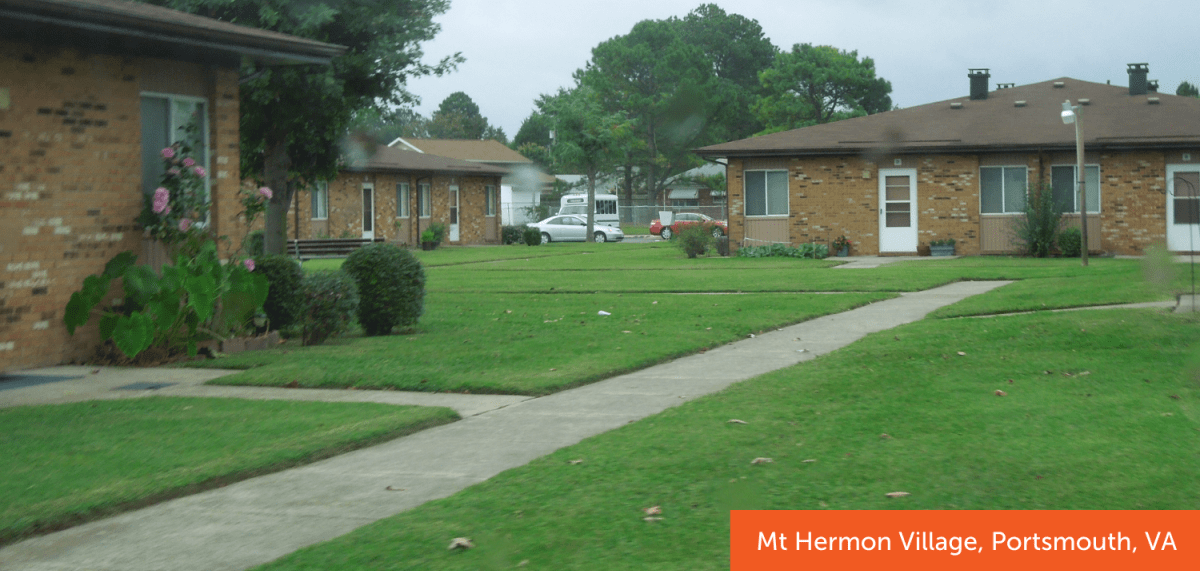
Climate Resilience and Older Adults: Making the Connection to Affordable Housing
NHT has long focused on the affordable housing needs of older Americans and the impacts of climate change to our affordable housing stock. We currently own and operate close to 4000 homes that provide safe, affordable shelter for individuals and families. Approximately ten percent of our residents are older adults, and at one of our communities in Virginia (Mt. Hermon Village), nearly all of the residents in the 90-unit building are low-income seniors and people with disabilities. NHT is currently developing a new affordable senior housing community in Washington, DC that will deliver 112 homes for people 55 and over. And NHT’s work to ensure that climate investments reach residents of affordable multifamily housing – through advocacy, capacity building, and in our properties – benefits all of our residents, including older adults. Under the leadership of Danielle Arigoni, we have begun to crosswalk our senior housing and climate work. Danielle recently published Climate Resilience for an Aging Nation and shares below her and NHT’s journey toward an intentional focus on climate resilience for older Americans.
When I joined NHT in July 2022 after a 5-year stint at AARP, I brought with me a desire to understand how the aging of our nation intersects with the climate risks we face – and what that means for the housing we develop. NHT supported this ‘labor of love’ because of our organizational bias toward innovation, and to inform our advocacy for climate benefits that target those most impacted. That journey ultimately took the form of a book, Climate Resilience for an Aging Nation, that was published by Island Press in October 2023 and makes the case for why older adults should be the lens through which we work towards climate resilience. The reasons are many:
- Older adults are far more likely to die in climate-fueled disasters – as much as 2x, 3x, or even 4x more often than other ages – regardless of the type of disaster (hurricane, wildfire, winter storm, extreme heat) or location. This trendline has continued, largely unchanged, for the past two decades.
- While all ages must adapt to new climate conditions, older adults face additional challenges as a result of their health or financial conditions. It is estimated that 80 percent of people over 60 live with two or more chronic health conditions which makes them more vulnerable to extreme temperatures and smoke from wildfires; and 15 percent of people over 65 live near or below the poverty line, creating challenges to adequately prepare for, withstand, or recover from hotter days, more power outages, or damaged property as a result of extreme events.
- Contrary to popular opinion, the vast majority of older adults live in their own homes, outside of congregate facilities (like nursing homes or assisted living facilities). Close to 96 percent live in the community, and nearly 30 percent of older adults live alone. Older adults’ risk is directly impacted by their ability to transport themselves (20% of older adults don’t drive); to accurately assess climate threats and take steps to mitigate them (one in nine older adults live with Alzheimer’s disease); and to finance the investments needed to make their homes safer in the face of climate change.
- Older adults represent an ever-larger share of our population. One hundred years ago, one in 20 people was age 65; today one in six is. By 2034, the US will have more people over 65 than under 18 for the first time ever. Smart leaders are planning for this future now, and bringing an “age-friendly” lens to their decisions about housing, transportation, infrastructure… and climate resilience.
The approaches discussed in the book that plan for this future and reduce risk for older adults are ones that also benefit low-income households, people with disabilities, and others who are traditionally under-represented and unheard in climate resilience planning. Several of them are also activities that NHT works to advance every day.
- Accelerate investment in resilience measures for affordable housing that reduce utility costs, particularly through renewable energy sources. By eliminating volatility in heating and cooling costs older adults can avoid tradeoffs in what they can afford to pay for utilities, and how much heat or cold they can withstand. Read more about NHT’s recent research in how housing finance agencies encourage resilience in their Qualified Allocation Plans for Housing Credits here.
- Mitigate climate-related risks in the development and rehabilitation of affordable housing. For example, water infiltration can contribute to black mold that worsens indoor air quality and exacerbates respiratory diseases like COPD, experienced by at least 11 percent of older adults.
- Support development of multifamily housing that both reduces the carbon emissions associated with housing and fosters connection between residents to support their well-being. Particularly for older adults who are no longer in the workforce, live alone, and have limited mobility, informal touchpoints with neighbors and fellow residents that takes place in multifamily (as compared to single family detached) housing can significantly improve their ability to withstand climate-related changes and climate-fueled disasters.
There is more to do, of course. Most communities in the US are a long way from creating places that enable older adults to safely and affordably ‘age in place.’ Improvements are needed in transportation and healthcare, and new practices are needed in the fields of emergency management and utilities. NHT is doing our part by creating climate-ready affordable housing that serves the needs of older adults and others. But the holistic work that is needed begins with acknowledging that older adults are differently impacted by climate change, and that we have it in our power to center their needs in developing plans for resilience. Doing so better serves the growing share of older adults in our communities, and all of us as we age.

Managing Director for Policy and Solutions